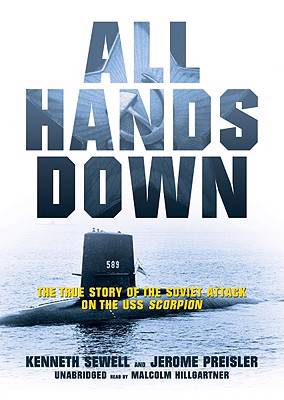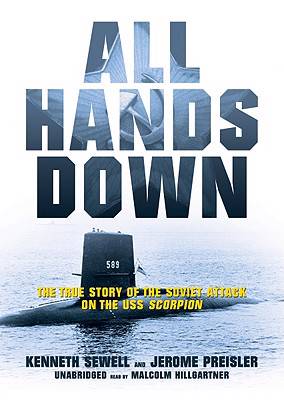
- Afhalen na 1 uur in een winkel met voorraad
- Gratis thuislevering in België vanaf € 30
- Ruim aanbod met 7 miljoen producten
- Afhalen na 1 uur in een winkel met voorraad
- Gratis thuislevering in België vanaf € 30
- Ruim aanbod met 7 miljoen producten
Zoeken
All Hands Down LUISTERBOEK
The True Story of the Soviet Attack on the USS Scorpion
Kenneth Sewell, Jerome Preisler
CD | Engels
€ 43,45
+ 86 punten
Uitvoering
Omschrijving
Forty years ago, in May 1968, the submarine USS Scorpion sank under mysterious circumstances, with a loss of ninety-nine lives. The tragedy occurred during the height of the Cold War between the United States and the Soviet Union and only weeks after the sinking of a Soviet sub near Hawaii. Now, drawing on hundreds of hours of interviews, many with exclusive sources in the naval and intelligence communities, as well as recently declassified United States and Soviet intelligence files, Kenneth Sewell and Jerome Preisler explain what really happened to Scorpion. In January 1968, a US intelligence ship, USS Pueblo, was seized by North Korea. Among other items, the North Koreans confiscated a valuable cryptographic unit that was capable of deciphering the navy's top-secret codes. Since a traitor named John Walker had begun supplying the navy's codes to the KGB, the Russians were able to read highly classified naval communications once the KGB acquired the crypto unit from the North Koreans. Then, in March, the Soviet sub K-129 mysteriously sank near Hawaii, hundreds of miles from its normal station in the Pacific. Soviet naval leaders mistakenly believed that a US submarine was to blame for the loss, instigating a plot for revenge. A trap was set: several Soviet vessels gathered in the Atlantic, their behavior suspicious. It would only be a matter of time before a US sub was sent to investigate. That sub was the Scorpion. Using the top-secret codes and the deciphering machine, the Soviets were able to intercept and decode communication between the navy and Scorpion, the final element in carrying out the planned attack. All Hands Down shows how the Soviet plan was executed and explains why the truth of the attack has been officially denied for forty years. Sewell and Preisler debunk various official explanations for the tragedy and bring to life the personal stories of some of the men who were lost when Scorpion went to the bottom. This engrossing true story is more exciting than any novel.
Specificaties
Betrokkenen
- Auteur(s):
- Uitgeverij:
Inhoud
- Taal:
- Engels
Eigenschappen
- Productcode (EAN):
- 9781433246203
- Verschijningsdatum:
- 1/06/2008
- Uitvoering:
- CD
- Formaat:
- MP3-formaat
- Afmetingen:
- 137 mm x 188 mm
- Gewicht:
- 95 g

Alleen bij Standaard Boekhandel
+ 86 punten op je klantenkaart van Standaard Boekhandel
Beoordelingen
We publiceren alleen reviews die voldoen aan de voorwaarden voor reviews. Bekijk onze voorwaarden voor reviews.











